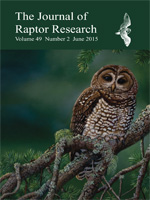Knowledge of the habitat characteristics that influence the distribution of raptors in the neotropics is vital for their conservation. I used logistic regressions (General Linear Models; GLM) to model habitat distribution for eleven raptor species occurring in the Cerros de Amotape National Park, the Tumbes National Reserve, and surrounding areas in northwestern Peru. Between May and December 2008 and 2009, raptors were surveyed along transects, and associated habitat data collected in 70 randomly allocated 1-km2 plots. Ten habitat variables were selected for modelling. Spatial autocorrelation in the distribution of species was measured through Moran's I and later habitat models were ranked using Akaike's Information Criterion corrected for small sample sizes (AICc). The most important variables that influenced the presence of species included the percentage of vegetation cover at different strata and elevation. The presence of the tree species, ceibo (Ceiba trichistrandra) and guasima (Guazuma ulmifolia), were also important. The percentage of vegetation cover from 5–15 m appeared in all models for Turkey Vulture (Cathartes aura), Crane Hawk (Geranospiza caerulescens), Great Black Hawk (Buteogallus urubitinga), and Harris's Hawk (Parabuteo unicinctus). These findings suggest that vertical structure of forested areas is of particular importance for raptors at the study site, including those of conservation concern. I recommend that forested areas north of the Cerros de Amotape National Park and close to Ecuador should be protected.
How to translate text using browser tools
1 June 2015
Habitat Associations Within a Raptor Community in a Protected Area in Northwest Peru
Renzo P. Piana

Journal of Raptor Research
Vol. 49 • No. 2
June 2015
Vol. 49 • No. 2
June 2015
general linear models
northwestern Peru
raptors
Tumbesian Endemic Centre
vegetation structure




